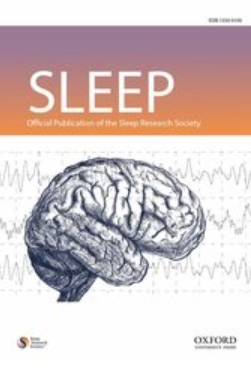Nocturnal Sleep Dynamics Alterations in the Early Stages of Behavioral Variant Frontotemporal Dementia
IF 5.6
2区 医学
Q1 Medicine
引用次数: 0
Abstract
Study Objectives Sleep disorders have been recognized as an integral component of the clinical syndrome in several neurodegenerative diseases, including Alzheimer's Disease (AD). However, limited data exists for rarer types of neurodegenerative diseases, such as behavioral variant Frontotemporal Dementia (bvFTD). This study aims to analyze EEG power spectra and sleep stage transitions in bvFTD patients, hypothesizing that bvFTD may show distinctive sleep stage transitions compared to patients with Alzheimer's Disease (AD). Methods Eighteen probable bvFTD patients and eighteen age- and sex-matched probable AD patients underwent overnight polysomnography (PSG) and completed sleep disorders questionnaires. Sleep questionnaires, full-night EEG spectra, and sleep stage transitions indexes were compared between groups. Results bvFTD patients had higher Insomnia Severity Index (ISI) scores (95%CI: 0, 5) and reported poorer sleep quality than AD patients (p<0.01). Compared to AD, bvFTD patients showed higher N1 percentage (95%CI: 0.1, 6), lower N3 percentage (95%CI: -13.6, -0.6), higher sleep-wake transitions (95%CI: 1.49, 8.86) and N1 sleep-wake transitions (95%CI: 0.32, 6.1). EEG spectral analysis revealed higher spectral power in bvFTD compared to AD patients in faster rhythms, especially sigma rhythm, across all sleep stages. In bvFTD patients, sleep-wake transitions were positively associated with ISI. Conclusions Patients with bvFTD present higher rates of transitions between wake and sleep than AD patients. The increased frequency of sleep transitions indicates a higher degree of sleep instability in bvFTD, which may reflect an imbalance in sleep-wake promoting systems. Sleep stage transitions analysis may provide novel insights into the sleep alterations of bvFTD patients.行为变异型额颞叶痴呆症早期的夜间睡眠动态变化
研究目的 睡眠障碍已被认为是包括阿尔茨海默病(AD)在内的多种神经退行性疾病临床综合征的组成部分。然而,关于行为变异性额颞叶痴呆症(bvFTD)等较罕见类型的神经退行性疾病的数据却很有限。本研究旨在分析 bvFTD 患者的脑电图功率谱和睡眠阶段转换,假设与阿尔茨海默病(AD)患者相比,bvFTD 患者可能表现出独特的睡眠阶段转换。方法 18 名疑似 bvFTD 患者和 18 名年龄和性别匹配的疑似 AD 患者接受了夜间多导睡眠图(PSG)检查,并填写了睡眠障碍问卷。对两组患者的睡眠问卷、整夜脑电图频谱和睡眠阶段转换指数进行了比较。结果 与AD患者相比,bvFTD患者的失眠严重程度指数(ISI)得分更高(95%CI:0,5),睡眠质量更差(p<0.01)。与 AD 相比,bvFTD 患者的 N1 百分比更高(95%CI:0.1, 6),N3 百分比更低(95%CI:-13.6, -0.6),睡眠-觉醒转换更高(95%CI:1.49, 8.86),N1 睡眠-觉醒转换更高(95%CI:0.32, 6.1)。脑电图频谱分析显示,与注意力缺失症患者相比,bvFTD患者在所有睡眠阶段的快节奏,尤其是σ节律的频谱功率更高。在 bvFTD 患者中,睡眠-觉醒转换与 ISI 呈正相关。结论 bvFTD 患者清醒与睡眠之间的转换率高于 AD 患者。睡眠转换频率的增加表明bvFTD患者的睡眠不稳定性更高,这可能反映了睡眠-觉醒促进系统的失衡。睡眠阶段转换分析可为了解bvFTD患者的睡眠改变提供新的视角。
本文章由计算机程序翻译,如有差异,请以英文原文为准。
求助全文
约1分钟内获得全文
求助全文
来源期刊

Sleep
Medicine-Neurology (clinical)
CiteScore
8.70
自引率
10.70%
发文量
0
期刊介绍:
SLEEP® publishes findings from studies conducted at any level of analysis, including:
Genes
Molecules
Cells
Physiology
Neural systems and circuits
Behavior and cognition
Self-report
SLEEP® publishes articles that use a wide variety of scientific approaches and address a broad range of topics. These may include, but are not limited to:
Basic and neuroscience studies of sleep and circadian mechanisms
In vitro and animal models of sleep, circadian rhythms, and human disorders
Pre-clinical human investigations, including the measurement and manipulation of sleep and circadian rhythms
Studies in clinical or population samples. These may address factors influencing sleep and circadian rhythms (e.g., development and aging, and social and environmental influences) and relationships between sleep, circadian rhythms, health, and disease
Clinical trials, epidemiology studies, implementation, and dissemination research.
 求助内容:
求助内容: 应助结果提醒方式:
应助结果提醒方式:


